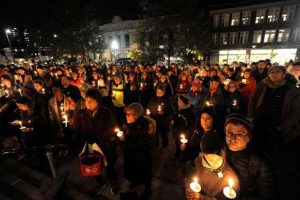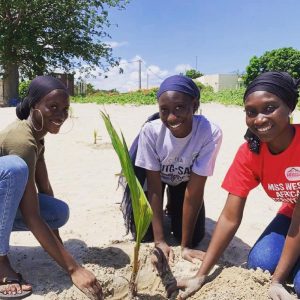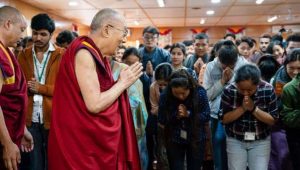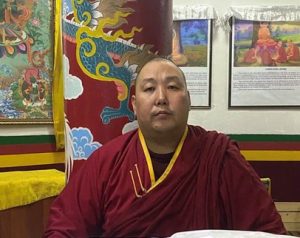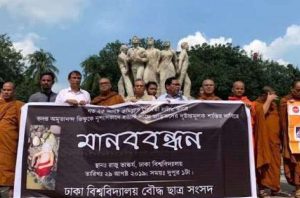
The state authorities have reportedly canceled the annual Dechen Shingdrup ceremony scheduled to be held at the renowned Larung Gar Buddhist Academy near Sertar, Garze Prefecture in China’s southwestern Sichuan Province. The news comes amid continued media reports on the ongoing state-ordered reduction of the institution’s monastic population, which has been accompanied by the demolition of an unverified number of residential buildings that sprawl across the sides of Larung Valley.
The eight-day festival, Dechen Shingdrup, (Accomplishing the Pure Land of Great Bliss), traditionally begins each year on the 18th day of the ninth month of the Tibetan lunar calendar, which this year falls on 17 November. “One of the main features of these assemblies is that senior religious instructors, reincarnate lamas, and other highly learned monks give religious sermons for three to four days to several thousand people who have gathered especially for the event,” said an unidentified source cited by the US-based news broadcaster Radio Free Asia. “But this year China has said this annual gathering may not take place, and instead the monks and nuns have begun to practice privately in their rooms. Meanwhile, the eviction of monks and nuns from Larung Gar continues.”

In June this year, Sertar County officials issued an order stating that by October 2017 only 1,500 monks and 3,500 nuns would be allowed to live at the monastic college. The order follows similar moves in 2001, when the state authorities organized a mass eviction of residents from the institute, and late last year, when further expulsions were accompanied by an order to reduce admissions to curb the rapid growth of the monastic population. The order did not give a reason for the decision, but cited two major government meetings during which Chinese President Xi Jinping had stressed “national unity” and the necessity for religious groups to support the Communist Party and “merge their religious doctrines with Chinese culture.” (Los Angeles Times)
Situated in the traditional Tibetan region of Kham, Larung Gar Buddhist Academy was founded in 1980 by the respected teacher Khenpo Jigme Phuntsok (1933–2004), a lama of the Nyingma tradition of Vajrayana Buddhism. With estimates putting the college’s total population at between 10,000 and as high as 40,000 monks and nuns, the institute is widely considered to be the largest center of Buddhist learning in the world.

As the state authorities continue to work on reducing the academy’s monastic population, media outlets report that evicted monks and nuns have been required to sign written pledges that they will not return to the religious center after they have been sent back to their hometowns. Reports say between 1,000 and 3,000 monastic residents have so far been expelled from the college. Three Tibetan nuns studying at the academy have reportedly committed suicide since the government began enforcing the eviction order.
According to some accounts, the main reasons given by the government for its actions at Larung Gar are to reduce overcrowding and to ensure public safety by renovating buildings. “It is common international practice to administrate religious sites in accordance with law,” The Chinese Embassy in London said in a statement cited by the International Business Times. “[Local authorities] aim to maintain order in the temples, provide better public and social services to the temples and their monks and nuns, eliminate risks in areas such as public security, fire control and public health, and create a good environment for the monks and nuns who are practicing in accordance with law and in good earnest.”
The site of Larung Gar was chosen by Khenpo Jigme Phuntsok because of its historical connection to the Vajrayana tradition. It is said that His Holiness the first Dudjom Rinpoche, Dudjom Lingpa (1835–1904) stayed here with his 13 disciples. The academy was conceived as an independent center of study that would help revitalize the Dharma and revive the study and practice of Tibetan Buddhism following China’s Cultural Revolution (1966–76), during which Tibetan Buddhism was suppressed and thousands of monasteries were destroyed. The institute has become renowned for the quality of both its religious and secular education. English, Chinese, and Tibetan languages and modern computer studies are taught alongside a traditional non-sectarian Buddhist curriculum. About 500 khenpos—holders of doctoral degrees in divinity—have studied at Larung Gar Buddhist Academy.
See more
China Cancels Annual Larung Gar Festival as Evictions Continue (Radio Free Asia)
Chinese authorities adopt new eviction tactics at Larung Gar (Phayul.com)
Thousands of Tibetan monks and nuns threatened with forced eviction by China (International Business Times)
For 2nd time in 15 years, Tibetan Buddhist academy in China faces demolition order (Los Angeles Times)
New footage reveals disturbing scenes at Larung Gar in Tibet (The Tibet Post International)
Over 1000 monks, nuns expelled, forced patriotic reeducation in Tibet (The Tibet Post International)
Larung Gar: China ‘destroys buildings’ at Tibetan Buddhist academy (BBC)
Related
Government Workers Begin Demolishing Buildings at Larung Gar Buddhist Academy (Buddhistdoor Global)
Chinese Authorities Plan Major Reduction of Monastic Population at Larung Gar (Buddhistdoor Global)
Chinese Government Orders Larung Gar Buddhist Institute to Reduce Admissions (Buddhistdoor Global)
Larung Gar Nuns Push for Gender Equality in Tibetan Buddhism (Buddhistdoor Global)
The Wonders of Kham and Larung Gar (Buddhistdoor Global)
The Wonders of Kham and Larung Gar, Part Two (Buddhistdoor Global)





